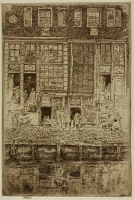KEYWORD
building, canal, children, façade, curtain, people, sculpture, shop, steps, window.
TITLE
Two basically different titles have been given to this work. Variations are as follows:
'
The Embroidered Curtain' (1890,
Beatrice Whistler (1857-1896)).
1
'
Lace Curtain' (1890,
Beatrice Whistler (1857-1896)).
2
'
Embroidered Curtain' (1890/1891, Whistler).
3
'
The Embroidered Curtain, Amsterdam' (1899, ISSPG).
4
'
The Embroidered Curtain' (1902,
Edward Guthrie Kennedy (1849-1932)).
5
'
The Lace Curtain' (1909,
Howard Mansfield (1849-1938)).
6
Although it is much more likely that the curtain was made of lace, Whistler's original title, and that used in 1899 when he was President of the International Society of Sculptors, Painters and Gravers (ISSPG) is definitely '
The Embroidered Curtain, Amsterdam'.
DESCRIPTION
A view across a canal, with two house façades and a cobbled pavement, reflected in the canal. The pavement is supported on wooden piles.
To left and right are steps leading to the double doors of the main floor, each with a narrow window above, and between these are two large many-paned windows. There are elaborate lace (or embroidered) curtains in the large windows on the main floor, and in the window above the open door to right.
On the brick façade of the second storey of each building are three windows, the central one flanked by two narrower ones. Under each of the larger windows are low-relief sculptures, possibly showing animals, and to left, a roundel bearing Whistler's butterfly.
Between the main steps are sub-basements, each entered by an open door at left, with a small window to right. Above the door at left is a sign reading 'WATER TE VUUR', and above the right hand door, another small window, while below it is a railing.
There are women and children in all the doorways except the main door at far right. There are also children on the pavement at far left, centre, and far right.
SITE
Whistler drew two scenes on a picturesque little canal, the Jordaan in Amsterdam, capital of the Netherlands:
The Embroidered Curtain, Amsterdam and
The Steps, Amsterdam
[452]. The former shows two of the step-roofed houses on the Palmgracht, numbers 52 and 54. In 1895 the canal was filled in and these houses were pulled down and replaced in the 20th century.
7
Whistler sketched the same view in an oil study, The Grey House
[y385] (reproduced below), but did not complete it.
 The Grey House
The Grey House
[y385], oil, 1889,
Freer Gallery of Art, F1903.182a-b.
The site was familiar to the Whistlers, being near their hotel in Amsterdam. Beatrice Whistler recorded
The Embroidered Curtain as 'Palmer Gracht', and a list of the copper plates in Whistler's studio included 'No. 1. Palmers. Gracht -'.
This was probably based on notes written on the envelopes or copper plates in Whistler's studio in 1901.
8
A photograph by
George Hendrik Breitner (1857-1923), who greatly admired Whistler's etchings, shows the frontage of Palmgracht 54, 52 and 50.
9
8: B. Whistler, [1890/1892], GUW #12715; Whistler to R. B. Philip, [8 March 1901], #04797.
9: RKD (Netherlands Institute for Art History), The Hague;
Heijbroek 1997
, pl. 79.
DISCUSSION
The sign above the entrance to a basement shop ('WATER TE VUUR') shows that it sold water and fire - a common small-scale business in Amsterdam 'where people paid a penny for a bucket of water or a few glowing coals'. 10
The Pennells praised 'the wonderful
Nocturne: Dance House,
The Embroidered Curtain,
The
Balcony, the
Zaandam in which he surpassed Rembrandt
in Rembrandt's own subjects.'
11 This was a generalisation, since none of the etchings by
Rembrandt Harmens van Rijn (1617-1681) actually resemble this composition, although there are clear comparisons with
Zaandam
[458].
This etching was mentioned favourably in 'A Chat With Mr Whistler' on 13 March 1890:
'Mr Whistler is not given to paying compliments to himself ... but in the chat I had with him over a cup of tea he admitted that his etchings of Amsterdam were, in his opinion, the best work he had ever given to the public. Last November Mr Whistler looked about him for new worlds to conquer, and elected to visit Amsterdam, which he thinks one of the most picturesque cities in Europe. He packed up his copper plates, his wax candles, his acids, his etching needles, and the various tools of the etcher, and proceeded to the quaint old capital of the Low Countries. The result will be given to the world in a series of ten etchings, which are practically completed. Proofs of these, enclosed in their dainty frames of white with black bars, reposed on the studio floor with their faces to the wall, and one after the other they were placed on the easel ... Here ... is a proof which Mr Whistler calls "the embroidered curtain". It [the curtain] hangs in a window overlooking one of the canals, and the delicate tracery of the pattern has been worked out to the minutest detail.' 12
Lochnan noted the geometrical abstraction of the underlying composition, rather than the realistic and decorative details:
'The surface of The Embroidered Curtain ... reads as a two-dimensional pattern which, with its asymmetrical arrangement of doors and windows and juxtaposition of patterns and textures, recalls the compositional structure of Japanese prints. The building was flattened to such an extent that it appears to hang like a veritable curtain in the middle distance. As such, this plate continues the tendency toward abstraction found in Palaces Brussels.' 13

